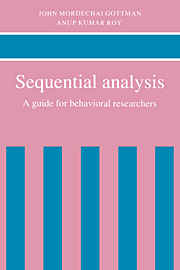Book contents
- Frontmatter
- Contents
- Preface
- Reading this book quickly
- Part I Introduction
- Part II Fitting the timetable
- Part III The timetable and the contextual design
- Chapter 10 Log-linear models
- Chapter 11 Log-linear models: review and examples
- Chapter 12 A single case analysis of the timetable
- Chapter 13 Logit models and logistic regression
- Chapter 14 The problem of autocontingency and its solutions
- Chapter 15 Recent advances: a brief overview
- Chapter 16 A brief summary
- References
- Index
Chapter 11 - Log-linear models: review and examples
from Part III - The timetable and the contextual design
Published online by Cambridge University Press: 10 November 2009
- Frontmatter
- Contents
- Preface
- Reading this book quickly
- Part I Introduction
- Part II Fitting the timetable
- Part III The timetable and the contextual design
- Chapter 10 Log-linear models
- Chapter 11 Log-linear models: review and examples
- Chapter 12 A single case analysis of the timetable
- Chapter 13 Logit models and logistic regression
- Chapter 14 The problem of autocontingency and its solutions
- Chapter 15 Recent advances: a brief overview
- Chapter 16 A brief summary
- References
- Index
Summary
Model Building and Selection of Categorical Data Modelsy
The selection of a log-linear model for describing a given data set becomes increasingly complicated as the number of variables increases, because of the rapid increase in possible associations and interactions. It is normally too cumbersome and demanding a task to fit all possible models once the number of dimensions exceeds three, and we thus need rules of thumb for selecting a specific model over others. As in fitting regression models, we have to balance two contradictory goals or objectives. On the one hand, we would prefer a model complex enough to afford a reasonably good fit of the data. On the other hand, we want a model that is relatively simple to interpret and that is parsimonious – one that smoothes rather than overfits the data.
Even though the partitioning and ordering properties of the likelihood ratio X2 statistic are very useful in assessing the relative worthiness of several (nested) candidate log-linear models, the process of finding the most appropriate – “best” fitting and parsimonious –(hierarchical) log-linear model is by no means an easy task. In general, we are able to fit all possible models for a three-way table; however, the number of hierarchical models to be fitted increases dramatically as the number of dimensions grows. Thus, for anything larger than a three-way table, we usually have to consider model selection strategies to limit the number to be evaluated for any given problem.
- Type
- Chapter
- Information
- Sequential AnalysisA Guide for Behavorial Researchers, pp. 133 - 167Publisher: Cambridge University PressPrint publication year: 1990



